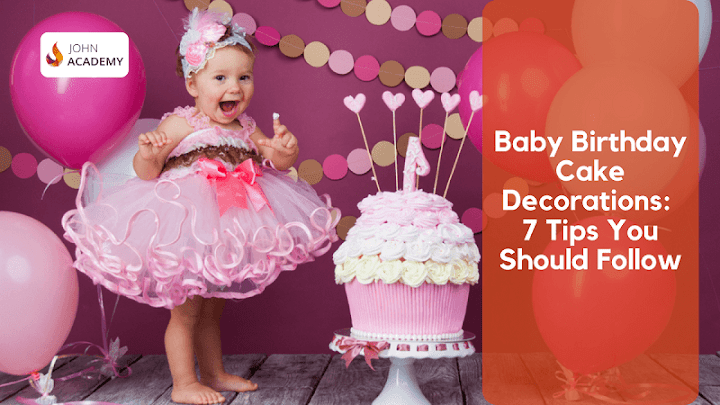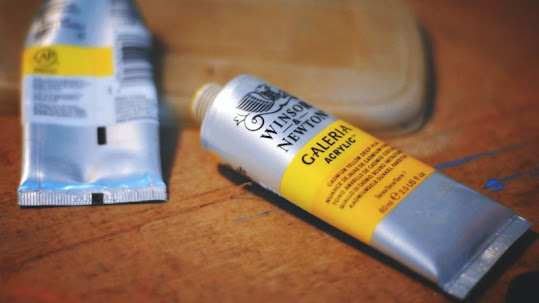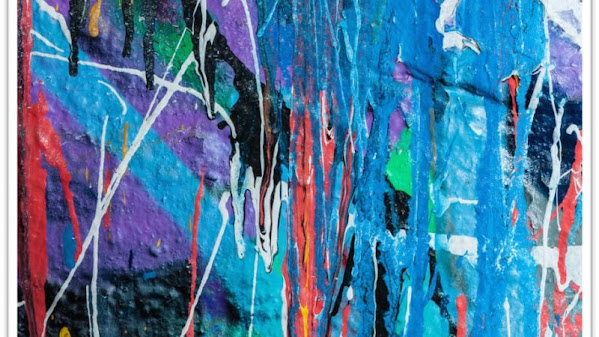Baby Birthday Cake Decorations: 7 Tips You Should Follow
carlitos ways
May 15, 2022
Baby Birthday Cake Decorations: 7 Tips You Should Follow
It smells like something is baking.
Oh, wait, are you baking a baby birthday cake?
Did you decide on the decoration yet?
Or are you new to this?
Let’s help you with the baby birthday cake decorations.
Whether you are new to this whole cake decorating thing or just looking for tips for baby birthday cake decorations, we got your back.
Let’s see how to make the best day for a baby even more special with 7 tips for baby birthday cake decorations.
Baby Birthday Cake Decorations
A baby’s birthday is a special occasion to celebrate.
Parents and family members want to rejoice and celebrate the baby’s growth from the moment the baby is born.
Though a baby, the little ones start to develop their personality and begin to have colour preferences and cartoons and characters they love.
The occasion is altogether incomplete if there is no cake in it.
A baby birthday cake is the centerpiece of decoration during the birthday celebration.
All the wishes are made, and birthday songs are sung around it.
Furthermore, the cake needs to have a really beautiful decoration to cheer your little one up and make the whole day memorable.
If you are making a birthday at home or taking a birthday cake order from your bakery, you need to keep many things in mind to make the best birthday cake.
Moreover, two things that you cannot compromise about a birthday cake are its taste and decoration.
The taste and decoration of the cake go hand in hand.
There should be a balance between the taste of the cake and its decoration whether you are making chocolate, vanilla, strawberry or red velvet cake.
Your decoration must also enhance its flavor if you are using edible decorations.
For the decoration of the cake, you need to figure out the details of the cake.
For example, its shape, layers, whether it should use frosting, icing or a fondant to cover the cake and the characters and decoration thing that you will use.
What is more, John Academy has a professional course Diploma in Baking & Cake Decorating.
Here, you can learn to make some spongy soft cakes, how to create layers, making amazing frosting and decorating them with all kinds of techniques like fondant.
Diploma in Baking & Cake Decorating
You’ll learn the secrets to making the perfect wedding cake, celebration cake and birthday cake like a pro.
You’ll learn the secrets to making the perfect wedding cake, celebration cake and birthday cake like a pro.
7 Tips for Baby Birthday Cake Decorations
If you are new to cake decorating, it may seem tricky at first.
However, achieving the decoration of a birthday can be fairly easy with simple tips and tricks, and we are all in to explain the details of baby birthday cake decorations.
1. Plan a Theme for the Cake
You must always plan the cake and have a theme for it.
The theme of the cake mostly depends on the person you are making it for.
Therefore, if you are taking orders for a baby birthday cake or making one for your own baby, try to find out what the baby likes the most.
You can go for the baby’s favorite color, which is one of the easiest themes to work with.
You can create any shape of the cake and give it a simple yet fun decoration using frosting of different colors scheme.
Likewise, you can also choose the baby’s favorite activity, toys, cartoon characters and so on to create the birthday cake of that shape and look.
Pick up an iconic feature of the baby’s favorite book, TV show, animals or characters that you can easily recreate without any hassle.
For example, you can create a panda cake with black and white frosting or a mini mouse cake with a pink bow.
2. Assemble Cake Decorating Tools
Having a stock of cake decorating supplies can be handy, even if it’s an occasional thing.
But if you are a professional baker or trying to be one, it is essential to have your supplies ready to decorate your customized cakes.
A baker is as good as the tool they are using to make and decorate the cake.
Firstly, turntables can be a lifesaver when it comes to decorating the cake.
It makes the cake frosting much easier and cleaner.
It also saves your energy that you might waste moving around the cake while decorating it.
Secondly, you will need knives and spatulas for cake decoration.
A serrated knife is handy for shaping the cake.
A frosting spatula or palette knife will help you to spread any kind of cream or frosting.
For frosting, you will also need frosting bags.
You can get it from stores and also make it at home, which is cheaper.
You will need a quarter or gallon-sized plastic or zip-lock bag depending on the amount of frosting you will use.
Last but most important are piping tools.
They are handy gadgets to decorate your cake just like you want with different styles and techniques.
You can find piping nozzles with different shapes and sizes with which you can design flowers by placing them in the hole of the frosting bags.
Here are some more lists of kits that you must need for decoration.
- Measuring cups
- Different kinds of knives
- Mixing bowls for frosting
- Electric beater
- Piping bag
- Scissors
- Stencils
- Toothpicks
- Candles
- Cookie-cutter
3. Decide Cake Toppings
You can do baby birthday cake decorations in any way you find it comfortable.
There are also plenty of edible cake decorations that you can place on top of the cake.
You can use lots of decorations like supplies that are edible and also inedible.
For inedible decorations, you can use figurines and models.
For example, you can find Barbie Elsa or Anna, place it on top of the cake and decorate it with other edible decorations.
Here are some of the edible decorations you must keep a stock of:
1. Chocolate chips
2. Edible glitter
3. Fondant
4. Food coloring
5. Frosting
6. Fruit
7. Nuts
8. Sprinkles
9. M&M’s
3 Simple Cake Decorating Hacks for Beginners
4. Check the Evenness of the Cake
When you are done baking the cake and just took it out of the oven.
The top of your cake might be uneven or have a domed shape.
Having a flat top makes it easier for you to frost and decorate it.
Otherwise, you might worry the cake will look uneven, and the decoration might slide down the dome portion of the cake.
You can correct it and make the cake even in many ways.
Firstly, if the cake is uneven or has risen to have a dome shape on top, then gently press a flat plate on top of your cake right after taking it out of the oven.
It will help to flatten the cake top.
Secondly, you can also trim the top of your cake using a serrated knife.
For this, you will also need a revolving turntable.
Start by cutting the edges of the cake by slowly rotating the cake.
Once the whole edge is done, slowly cut your way through the deeper part of the cake.
Do this till you have achieved a flat top.
Moreover, you can check the evenness of the cake by using a clean cupboard by placing it on top of the cake.
If the cardboard stays flat on top of the cake, then your cake is even.
You must also check the temperature of the oven, which can be the major reason for an uneven cake.
Too high a temperature may cause your cake to rise unevenly.
Avoid this issue by double-checking your oven temperature with a thermometer.
Do not forget to tap the cake tin baking try a few times.
5. Cool Down Your Cake Completely Before Decoration
For perfect baby birthday cake decorations, it is really important to completely cool down your cake after decorating it.
Decorating and frosting a warm cake will only cause the frost, fondant or icing to melt out and create a messy puddle of decoration.
Furthermore, the shape of the cake changes in size when it cools down.
Therefore, your decoration will be more stable if you work with a cool cake.
Here are the things you can do to cool down your cake.
- Place your cake on a cooling rack or on a counter away from any kind of heat for 5-10 minutes.
- For cooling quicker and also locking the moisture of the cake, put it in the refrigerator.
- Wrap 2 layers of plastic wrap around the cake and seal it inside a mould to stop it from drying out.
- Place your cake back into the refrigerator for 1-2 more hours.
Now let’s come to the most important part of the baby birthday cake decorations.
It is time for frosting.
From the taste of your frosting to the texture and color of your frosting, everything impacts the overall taste and decoration of the cake.
So we will discuss some common frosting that you can use for baby birthday cake decorations.
a. Buttercream Frosting
The most common form of frosting is buttercream frosting, and it goes along with almost any kind of cake.
It is made from beating the butter with an electric beater until it’s fluffy and creamy.
Once the butter has reached a glazy and creamy texture, you need to add powdered sugar gradually and beat the mixture until it becomes creamy and light.
You can also modify the buttercream frosting by adding some flavors like Vanilla, Chocolate, or Lemon.
You can also add food color to modify its color.
b. Whipped Cream Frosting
You can prepare whipped cream by whipping heavy cream with powdered sugar until it holds its peaks.
Whipped cream goes well with chocolate, black forest or pineapple cake.
c. Cream Cheese Frosting
This is a variety of the classic Buttercream frosting, with the primary components being butter, sugar, cream cheese, and lemon for extra flavor.
Red Velvet Cake, Carrot Cake, and Lemon Cake are the most popular cakes with cream cheese frosting.
d. Meringue Frosting
Meringue frosting is formed by beating egg white on a double boiler and combining them with sugar until they are opaque white and very creamy and fluffy in texture.
After decorating the Meringue, it’s also popular to toast it using a blowtorch.
One of the biggest problems you will face while frosting your cake is that the cake crumbs mix with the frosting you are using.
As a result, your cake might not look so clean and look rough.
This brings us to the next tip of baby birthday cake decorations which is to crumb coat your cake before applying the frosting.
A crumb coat is layering your cake with a thin layer of frosting before applying the main layer of frosting.
The crumbs will be trapped by your crumb coat, which will preserve your main layer of frosting, making it look nice and clean.
To do the crumb coating, spread a thin layer of frosting with a knife or an offset spatula until you can see the cake underneath.
Leave the cake in a refrigerator for 30 minutes to 24 hours so that the coating is set in properly.
Apply the main layer of frosting after the crumb coating is set and achieve a smoothly frosted cake.
You can add details and designs to your cake using a piping bag.
Fill up a piping bag with frosts and use the end of the piping bag to direct the stream of frost.
For this, cut the tip of your piping bag according to the thickness of the design you want to create.
You can also buy nozzles or tips for your piping bag with different designs.
Here are some of the different shapes and designs you can create with special effect tips or nozzles.
1. You can use round tip nozzles to line the border of the cake.
You can create simple lines with them, dots and write messages with them on the cake.
2. With the help of a star tip nozzle, you can create shapes like stars, flowers, shells, boarders and rosettes.
3. Through basket-weave tips, you create lattices and lines that look like ribbons, and you can make many other amazing borders and designs.
Diploma in Baking & Cake Decorating
You’ll learn the secrets to making the perfect wedding cake, celebration cake and birthday cake like a pro.
Enrol Now
Diploma in Baking & Cake Decorating
You’ll learn the secrets to making the perfect wedding cake, celebration cake and birthday cake like a pro.
Enrol Now
Ready to Decorate!
Following these tips, you can make baby birthday cake easily and beautifully.
Apply your creativity or take inspiration from plenty of different baby birthday cake decorations you can find online.
If it is your first time, start it simple, and if you follow these tips, you can create a beautiful cake.
Read more blogs





























